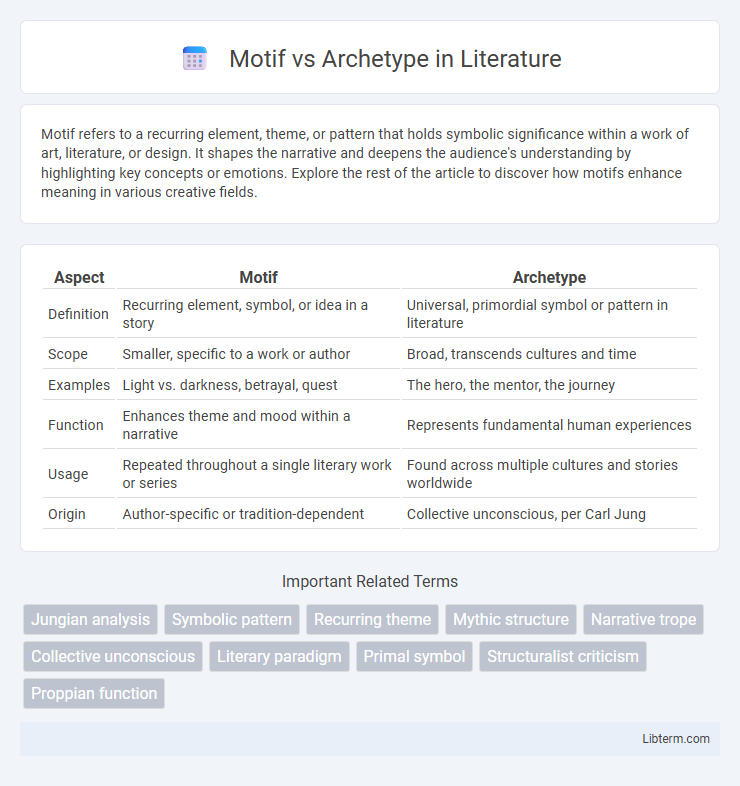Motif refers to a recurring element, theme, or pattern that holds symbolic significance within a work of art, literature, or design. It shapes the narrative and deepens the audience's understanding by highlighting key concepts or emotions. Explore the rest of the article to discover how motifs enhance meaning in various creative fields.
Table of Comparison
| Aspect | Motif | Archetype |
|---|---|---|
| Definition | Recurring element, symbol, or idea in a story | Universal, primordial symbol or pattern in literature |
| Scope | Smaller, specific to a work or author | Broad, transcends cultures and time |
| Examples | Light vs. darkness, betrayal, quest | The hero, the mentor, the journey |
| Function | Enhances theme and mood within a narrative | Represents fundamental human experiences |
| Usage | Repeated throughout a single literary work or series | Found across multiple cultures and stories worldwide |
| Origin | Author-specific or tradition-dependent | Collective unconscious, per Carl Jung |
Understanding Motif and Archetype
Motifs are recurring elements, symbols, or ideas within a narrative that reinforce themes and contribute to the story's mood or tone, such as a repeated image of darkness symbolizing mystery or fear. Archetypes are universal, symbolic patterns or characters that appear across cultures and literature, like the Hero, the Mentor, or the Journey, representing fundamental human experiences and emotions. Understanding motifs and archetypes helps deepen the analysis of literature by revealing underlying structures and meanings that resonate on both individual and collective levels.
Defining Literary Motifs
Literary motifs consist of recurring symbols, themes, or ideas that reinforce the narrative's underlying message and contribute to the story's emotional impact. These motifs differ from archetypes, which are universal, primordial patterns or characters that exist across cultures and time. Motifs often support and enhance archetypes by providing specific contextual details within a particular work.
Exploring Common Archetypes
Common archetypes such as the Hero, the Mentor, and the Shadow represent universal patterns that resonate across cultures and narratives, serving as foundational building blocks in storytelling. Motifs are recurring elements, like a symbol or theme, that support the development of these archetypes by reinforcing their underlying qualities and emotional impact. Analyzing motifs alongside archetypes deepens the understanding of character roles and thematic messages within literary and cinematic works.
Key Differences Between Motif and Archetype
Motifs are recurring symbols, themes, or ideas that reinforce the narrative's central messages, while archetypes are universal, timeless characters, symbols, or patterns that resonate across cultures and literature. Motifs often appear as repeated elements that support the story's mood or theme, whereas archetypes serve as foundational templates for characters and plot structures. The key difference lies in motifs being specific to a particular work and its message, whereas archetypes represent broad, collective myths or human experiences embedded in storytelling.
The Function of Motifs in Storytelling
Motifs serve as recurring thematic elements that reinforce the story's central ideas and enhance emotional resonance. They help create cohesion and continuity by subtly reminding the audience of underlying messages or character traits throughout the narrative. Unlike archetypes, which represent universal character models or symbols, motifs are specific symbols or phrases that support storytelling by emphasizing mood and thematic development.
Archetypes and Their Universal Appeal
Archetypes represent fundamental, universal symbols and themes that resonate deeply across cultures and time, embodying innate human experiences such as the Hero's journey, the Mentor, or the Shadow. Their universal appeal lies in their ability to evoke shared emotions and collective unconscious patterns, making stories and characters instantly recognizable and relatable. Unlike motifs, which are recurring elements or symbolic details within a narrative, archetypes provide the foundational framework that shapes character roles and overarching story dynamics.
Examples of Motifs in Literature
Motifs in literature are recurring elements, such as symbols, themes, or phrases, that reinforce the central narrative, like the green light in F. Scott Fitzgerald's *The Great Gatsby* symbolizing hope and the American Dream. Unlike archetypes, which represent universal, primordial characters or themes such as the Hero or the Mentor found across various cultures and stories, motifs are specific to individual works and deepen the story's meaning. Other notable examples of motifs include Edgar Allan Poe's use of the raven in *The Raven* to evoke mourning and loss, and Shakespeare's repeated references to darkness and light in *Macbeth* to symbolize evil and knowledge.
Examples of Archetypes in Myth and Fiction
Archetypes in myth and fiction include the Hero, represented by characters like Hercules and King Arthur, embodying courage and strength. The Mentor appears as figures such as Gandalf in "The Lord of the Rings" or Dumbledore in "Harry Potter," guiding the protagonist with wisdom. The Shadow archetype includes villains like Darth Vader from "Star Wars," symbolizing the darker aspects of the hero's journey and internal conflict.
How Writers Use Motifs and Archetypes
Writers use motifs to reinforce central themes through repeated symbols, images, or ideas that create a cohesive narrative experience. Archetypes serve as universal character types, settings, or plot patterns that resonate with audiences by tapping into shared human experiences and cultural myths. Employing motifs and archetypes together enriches storytelling by layering meaning and fostering emotional connection.
Impact of Motifs and Archetypes on Readers
Motifs and archetypes significantly enhance readers' engagement by evoking strong emotional responses and creating universal connections across narratives. Motifs reinforce themes and provide a consistent thread that deepens understanding, while archetypes tap into collective unconscious, enabling readers to recognize familiar patterns and characters instantly. This synergy enriches storytelling by fostering empathy and making complex ideas more accessible and memorable.
Motif Infographic

 libterm.com
libterm.com